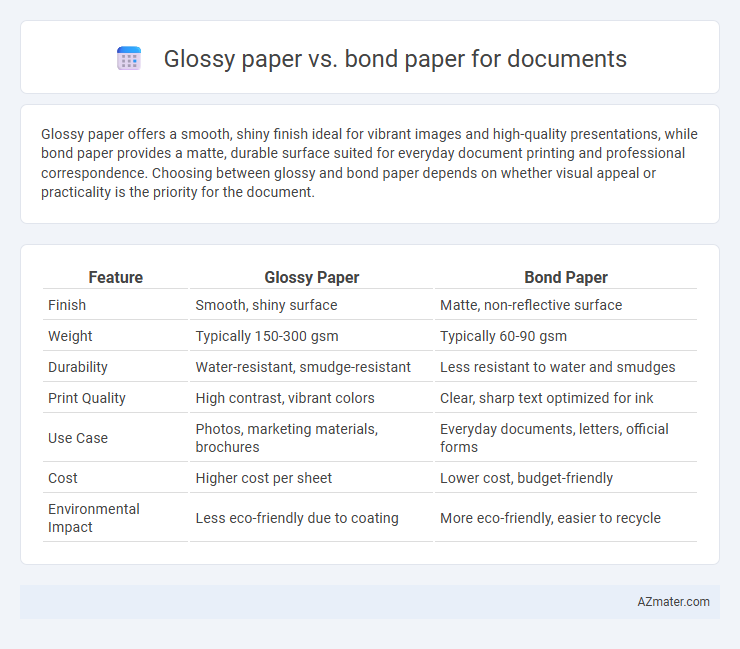Glossy paper offers a smooth, shiny finish ideal for vibrant images and high-quality presentations, while bond paper provides a matte, durable surface suited for everyday document printing and professional correspondence. Choosing between glossy and bond paper depends on whether visual appeal or practicality is the priority for the document.
Table of Comparison
| Feature | Glossy Paper | Bond Paper |
|---|---|---|
| Finish | Smooth, shiny surface | Matte, non-reflective surface |
| Weight | Typically 150-300 gsm | Typically 60-90 gsm |
| Durability | Water-resistant, smudge-resistant | Less resistant to water and smudges |
| Print Quality | High contrast, vibrant colors | Clear, sharp text optimized for ink |
| Use Case | Photos, marketing materials, brochures | Everyday documents, letters, official forms |
| Cost | Higher cost per sheet | Lower cost, budget-friendly |
| Environmental Impact | Less eco-friendly due to coating | More eco-friendly, easier to recycle |
Understanding Glossy Paper and Bond Paper
Glossy paper features a shiny, smooth coating that enhances color vibrancy and sharpness, making it ideal for high-quality photo prints and marketing materials, while bond paper is uncoated, lightweight, and more porous, designed for everyday printing and writing with better ink absorption and durability. Glossy paper's reflective surface can cause glare and is less suitable for text-heavy documents, whereas bond paper provides a matte finish that reduces eye strain during extensive reading and is more cost-effective for bulk printing. Understanding these differences helps in selecting the appropriate paper type based on the document's purpose, whether visual impact or practicality and readability.
Key Differences Between Glossy and Bond Paper
Glossy paper features a shiny, reflective coating that enhances color vibrancy and sharpness, making it ideal for high-quality photo prints and marketing materials. Bond paper, typically matte and uncoated, offers durability and smoothness suited for everyday printing, official documents, and typing. While glossy paper excels in visual appeal, bond paper prioritizes practicality and legibility for text-heavy content.
Print Quality: Glossy vs Bond Paper
Glossy paper offers superior print quality with vibrant colors and sharp details, making it ideal for photos and high-resolution images, while bond paper provides a smooth, matte finish that ensures clear, legible text suitable for everyday documents and reports. The glossy surface enhances contrast and color depth, but it is prone to fingerprints and glare, whereas bond paper excels in durability and ease of writing or scanning. Choosing between glossy and bond paper depends on whether the priority is visual impact or functional clarity in printed documents.
Ideal Uses for Glossy Paper
Glossy paper offers vibrant color reproduction and a smooth, reflective finish, making it ideal for professional presentations, brochures, and photo prints where visual impact is crucial. Its high-quality surface enhances detailed images and sharp graphics, perfect for marketing materials and portfolios that require a polished look. Glossy paper is less suitable for everyday documents, where readability and ease of writing are priorities, and bond paper remains the practical choice.
Best Applications for Bond Paper
Bond paper excels in document printing due to its durability, smooth texture, and excellent print quality, making it ideal for official reports, legal documents, and business correspondence. Its strong fiber composition allows for easy handling and enhances ink absorption, ensuring long-lasting readability and professional presentation. Bond paper is also preferred for everyday office use and archival records where cost-effectiveness and reliability are crucial.
Durability Comparison: Glossy vs Bond Paper
Glossy paper offers a smooth, shiny finish that enhances image quality but is generally less durable than bond paper, as it tends to scratch and wrinkle more easily. Bond paper, typically made from wood pulp with a rougher texture, withstands frequent handling and exposure to environmental factors better, making it ideal for documents requiring long-term durability. For documents needing longevity and resistance to wear, bond paper provides superior strength and durability compared to glossy paper.
Cost Analysis: Which Paper is More Economical?
Glossy paper typically costs more per sheet due to its specialized coating, making it less economical for large-volume document printing compared to bond paper, which is widely available and budget-friendly. Bond paper's affordability and versatility make it the preferred choice for everyday office use and bulk printing tasks. For projects requiring visual appeal, the higher cost of glossy paper may be justified, but for standard documents, bond paper offers significant cost savings.
Environmental Impact: Glossy vs Bond Paper
Glossy paper, often coated with chemical-laden finishes, poses greater environmental challenges during production and disposal compared to bond paper, which is typically uncoated and more biodegradable. The manufacturing process of glossy paper consumes more energy and involves non-recyclable polymers, leading to increased landfill waste. Bond paper, favored for its recyclability and lower carbon footprint, supports sustainable document printing practices with reduced ecological impact.
Choosing the Right Paper for Your Documents
Glossy paper offers vibrant color reproduction and sharp images, making it ideal for photo prints and presentation materials, while bond paper provides a smooth, sturdy surface suited for everyday printing, official documents, and text-heavy pages. When choosing the right paper for your documents, consider the purpose, durability, and printer compatibility; bond paper excels in cost-effectiveness and professional appearance for letters and reports. Opt for glossy paper when high-impact visuals are required to enhance viewer engagement or brand presentation.
Final Verdict: Glossy or Bond Paper for Document Printing
Glossy paper offers vibrant color reproduction and sharp detail, making it ideal for marketing materials and photo-heavy documents, whereas bond paper delivers a professional look with superior durability and easy writing suitability, perfect for text-heavy reports and official correspondence. For everyday document printing, bond paper remains the preferred choice due to its cost-effectiveness and resistance to smudging or fingerprint marks. Choosing between glossy or bond paper depends primarily on the document's purpose--opt for glossy for visual impact and bond for practicality and readability.

Infographic: Glossy paper vs Bond paper for Document
 azmater.com
azmater.com